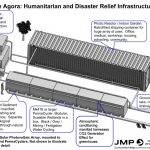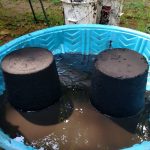#15: An Open Invite to Elon Musk
Dear Elon, I love what you are doing, hold your course. You will help get us back to the Moon and onwards to Mars within the next decade. But how will we remain there?
How does humanity survive in an environment that is anathema to our metabolism? The Moon is harsher than Mars, but it is closer. With SpaceX, Nasa and others, along with economy of scale, we could reasonably resupply a non-farming base on the moon. Not so with Mars.
I’ve been doing my homework on current International Space Station solutions for water/waste treatment and cycling. They are durable, well understood and engineered, but none fully eliminate or reuse a mixed water waste stream (black/grey/lab water).
Research is being conducted into plant growth on ISS for food, but modern aquaponics have yet to come into its own in space. Also, there is limited consideration for how a space vessel is built around its permanent life support ecosystem. We can’t survive in a sterile environment, nor can we maintain abiotic environments no matter the available energy and mass committed. Humans are infested with and survive because of microbes of all varieties. We must travel to the stars with our native ecosystems in order to permanently survive away from Earth.
Mr Musk, Ive been building and patenting the self selecting microbial bioreactor (SSBR) for about six years now.
As such, I’m the world expert in the field I honestly just stumbled upon. I’ve partnered with the Smithsonian and Penn State and we have a pending National Science Foundation grant to use biogenic mine waste for waste treatment and cycling.
In acid mine drainage, from whence the SSBR developed, current best management practice is to build special ponds to suit a specific pollutant load. If flow or maintenance go out of spec, the system fails. These one-offs (sound familiar?) are built to engender and maintain one specific niche till that part of the mixed pollutant load is sequestered or converted to something non toxic or ready for further reactions. If conditions change, and too much of this pollutant gets past its purpose built embodiment, everything downstream crashes. They also aren’t designed to extract valuable materials, while the SSBR biologically separates elements and molecules through easy to control shifts in population, Reduction/Oxidation (eH), pH and temperature.
The SSBR, which goes under different names depending on what is flowing through it (MRU for mining, PermaCycler for Ag), acts like a biological distillation system. Add to that conceptual framework 3.8 billion years of microbial evolution which engenders and controls feedback loops. Now, add the vessel, the reactor, and design it so changes in flow and pollutants move the microbial transition point backwards and forwards smoothly in the treatment train, with no crash.
Each SSBR is modular, scalable, and exactly the same. Populations of microbes swell and shrink as they gain and lose reproductive advantage bequeathed by the incoming load and abiotic parameters. A diverse culture of microbial biofilm can thus respond to wide ranges of impacts without crashing. Think of it like the space ship’s living wetland guts, one or many long (folded helix, familiar) reactors strung together with biology and load flowing freely downstream.
Specific reactor strings are purposed for different waste streams. For example, grey/black/COD rich loads and aquaponic and nutrient specific loads. By limiting miscible elements (sodium, chlorine…) and utilizing them as micronutrients, biological uptake removes them from the waste stream, reducing RO’s energy, material, and waste requirements. On demand potable water using micro-pore and UV filtration/sterilization is the smallest string or tank, as there is no point in having water sitting around, not being used to grow life.
The bulk of the water in a Space Vessel is stored in the aquaponic loops, with different string of reactors supporting this main bio-sink. Added benefit to having lots of water, lots of propellant, lots of O2/H2, and back to lots of water if not needed by way of a good old fashioned fuel cell.
The water budget on a vessel, and the decisions that are made concerning propulsion or hydration, can be made with much more versatility.
In the event of a large SSBR impact, like increased flow or a particularly harsh chemical or biocide, rebound time is not immediate, but well known and understood conditions, such as temperature, O2 saturation, flow rate, and injected amendments can get an SSBR, back on its feet in hours to a day. Biofilms with specific populations can be re-constituted by thawing a frozen sample, set back from an earlier time, and reintroduced into the stream to re-constitute the microbial niche.
The SSBR’s are the core of the ships environmental control and life support system. All air, water, and waste is processed by the sum of the SSBR’s unified treatment train. To say the SSBR is the most important part of the ECLSS would be incorrect, because the other side of the coin, the oxygen producing green space and its root/growth matrix, is required to balance the carbon dioxide produced by the SSBR’s satisfaction of biochemical oxygen demand. Its Yin and Yang, and I find it poetically practical.
Concerning vessel design, SSBRs are built into the central spire or haul for added radiation defense and act as heat sinks, green space, and seed bank.
The entire ecosystem is ran at standard pressure and temperature and, minus lights for plant growth, requires 1-2 kws of energy for pumps, low pressure injectors, and monitors. The rest of the work is done by the microbial and plant ecology which supports the crew, as it does on Earth.
I propose EcoIslands and SpaceX team up to design and build the first crewed space ship with a wetland as heart, lungs, and gut of a deep space vessel. The Dr John Edward Lennox, named for my late father, will be the first space vessel to harness a semi-closed loop ecology as its primary environmental cycler, using bio-geo-electro-chemistry to catalyze the vessels hyper efficiency. Current treatment technologies are used in conjunction and backup, not as prime process. This traveling ecosystem will act as vanguard and culture for new ecologies developed in each discrete unit colonized by humanity.
Elon, you can get us there, and we can keep us there permanently. Let’s do this for my dad. Let’s do this for all of us.
Yours,
Colin






Nice tribute to your father Colin. It is great to know how you are progressing with this both in space and here on earth. Both are needed as are fertile minds like yours. Your Dad would continue to be pleased with your efforts. As his brother, your uncle and another member of the scientific community thanks for keeping us mindful of how the future might be shaped by efforts such as these. I am sure that Mr. Musk will agree.
Robert W. Lennox, ScD
Thank you Bob. I hope he was as proud of me as I am of you and dad. This blog post is actually getting some attention and has already taken me to Ames Science Center, Singularity University, and the Pentagon, so we’ll get the Dr. John Edward Lennox flying one day.